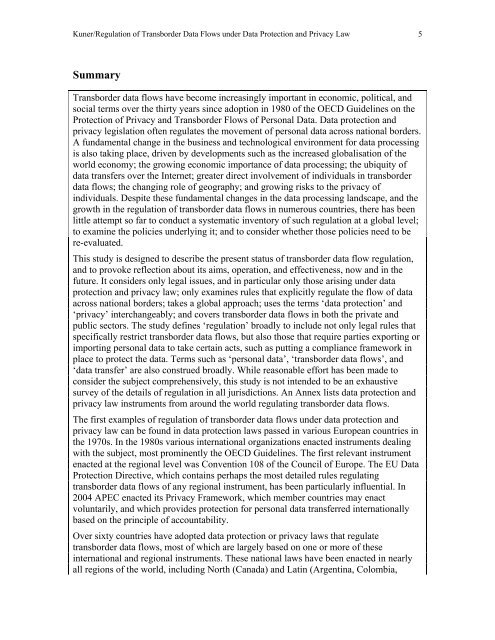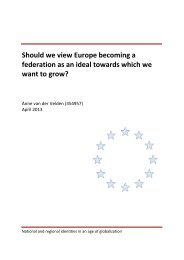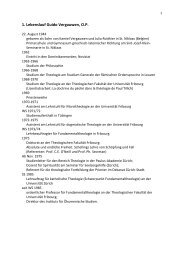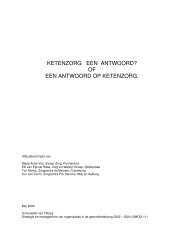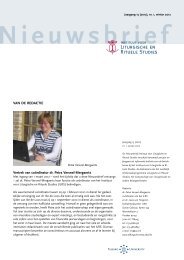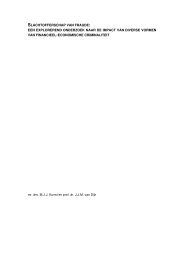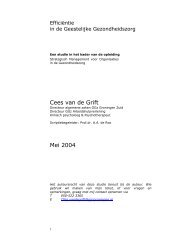Regulation of Transborder Data Flows under ... - Tilburg University
Regulation of Transborder Data Flows under ... - Tilburg University
Regulation of Transborder Data Flows under ... - Tilburg University
You also want an ePaper? Increase the reach of your titles
YUMPU automatically turns print PDFs into web optimized ePapers that Google loves.
Kuner/<strong>Regulation</strong> <strong>of</strong> <strong>Transborder</strong> <strong>Data</strong> <strong>Flows</strong> <strong>under</strong> <strong>Data</strong> Protection and Privacy Law 5<br />
Summary<br />
<strong>Transborder</strong> data flows have become increasingly important in economic, political, and<br />
social terms over the thirty years since adoption in 1980 <strong>of</strong> the OECD Guidelines on the<br />
Protection <strong>of</strong> Privacy and <strong>Transborder</strong> <strong>Flows</strong> <strong>of</strong> Personal <strong>Data</strong>. <strong>Data</strong> protection and<br />
privacy legislation <strong>of</strong>ten regulates the movement <strong>of</strong> personal data across national borders.<br />
A fundamental change in the business and technological environment for data processing<br />
is also taking place, driven by developments such as the increased globalisation <strong>of</strong> the<br />
world economy; the growing economic importance <strong>of</strong> data processing; the ubiquity <strong>of</strong><br />
data transfers over the Internet; greater direct involvement <strong>of</strong> individuals in transborder<br />
data flows; the changing role <strong>of</strong> geography; and growing risks to the privacy <strong>of</strong><br />
individuals. Despite these fundamental changes in the data processing landscape, and the<br />
growth in the regulation <strong>of</strong> transborder data flows in numerous countries, there has been<br />
little attempt so far to conduct a systematic inventory <strong>of</strong> such regulation at a global level;<br />
to examine the policies <strong>under</strong>lying it; and to consider whether those policies need to be<br />
re-evaluated.<br />
This study is designed to describe the present status <strong>of</strong> transborder data flow regulation,<br />
and to provoke reflection about its aims, operation, and effectiveness, now and in the<br />
future. It considers only legal issues, and in particular only those arising <strong>under</strong> data<br />
protection and privacy law; only examines rules that explicitly regulate the flow <strong>of</strong> data<br />
across national borders; takes a global approach; uses the terms ‘data protection’ and<br />
‘privacy’ interchangeably; and covers transborder data flows in both the private and<br />
public sectors. The study defines ‘regulation’ broadly to include not only legal rules that<br />
specifically restrict transborder data flows, but also those that require parties exporting or<br />
importing personal data to take certain acts, such as putting a compliance framework in<br />
place to protect the data. Terms such as ‘personal data’, ‘transborder data flows’, and<br />
‘data transfer’ are also construed broadly. While reasonable effort has been made to<br />
consider the subject comprehensively, this study is not intended to be an exhaustive<br />
survey <strong>of</strong> the details <strong>of</strong> regulation in all jurisdictions. An Annex lists data protection and<br />
privacy law instruments from around the world regulating transborder data flows.<br />
The first examples <strong>of</strong> regulation <strong>of</strong> transborder data flows <strong>under</strong> data protection and<br />
privacy law can be found in data protection laws passed in various European countries in<br />
the 1970s. In the 1980s various international organizations enacted instruments dealing<br />
with the subject, most prominently the OECD Guidelines. The first relevant instrument<br />
enacted at the regional level was Convention 108 <strong>of</strong> the Council <strong>of</strong> Europe. The EU <strong>Data</strong><br />
Protection Directive, which contains perhaps the most detailed rules regulating<br />
transborder data flows <strong>of</strong> any regional instrument, has been particularly influential. In<br />
2004 APEC enacted its Privacy Framework, which member countries may enact<br />
voluntarily, and which provides protection for personal data transferred internationally<br />
based on the principle <strong>of</strong> accountability.<br />
Over sixty countries have adopted data protection or privacy laws that regulate<br />
transborder data flows, most <strong>of</strong> which are largely based on one or more <strong>of</strong> these<br />
international and regional instruments. These national laws have been enacted in nearly<br />
all regions <strong>of</strong> the world, including North (Canada) and Latin (Argentina, Colombia,


